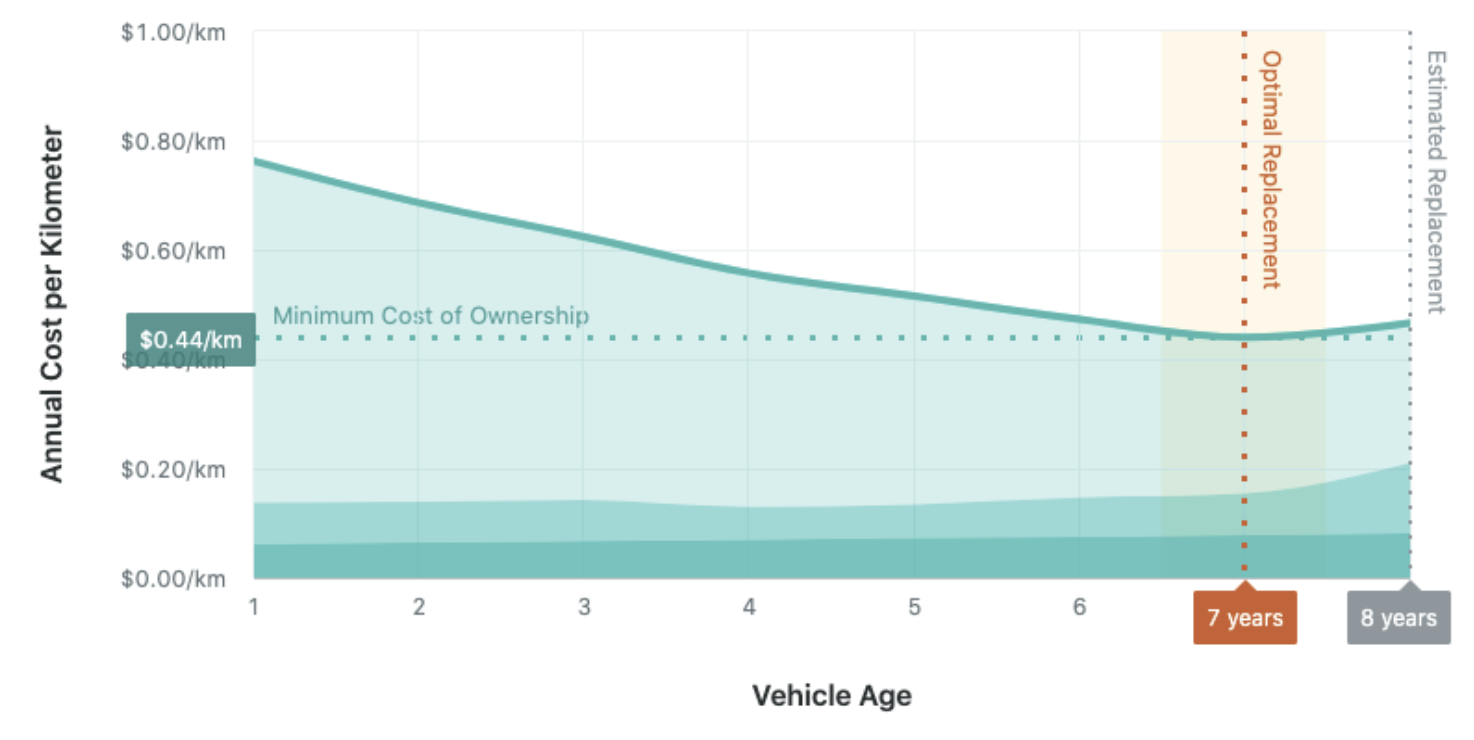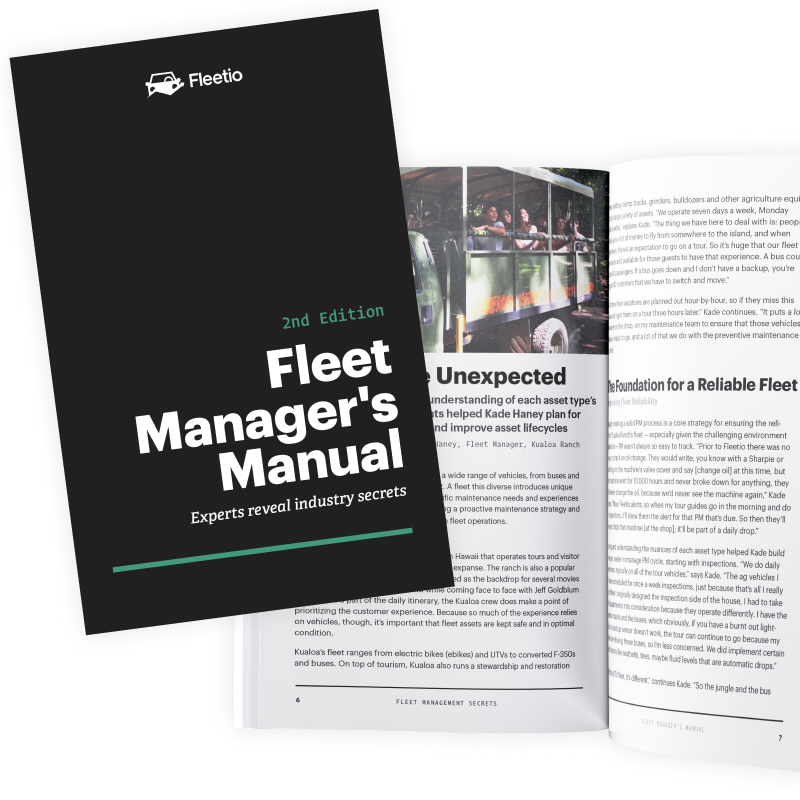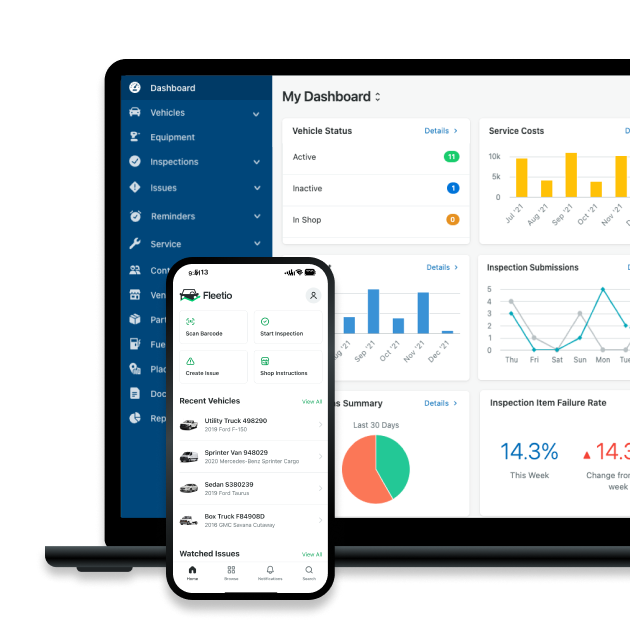Fleet Management Cost Analysis: A Complete Guide
Fleet management cost analysis is the most effective way to make data-driven decisions to maximize profitability. Using software makes it easy to track expenses and centralize your data.
Aug 10, 2023 | Updated: Jul 1, 2025
8 min read

TL;DR: What is a fleet management cost analysis?
Fleet management cost analysis helps you understand where every dollar goes — so you can reduce expenses, improve ROI, and make smarter decisions. Using software like Fleetio makes it easier to track spending in real time and optimize your strategy.
Key takeaways:
- Track total cost of ownership (TCO): Use software to monitor both fixed (insurance, depreciation) and variable (fuel, maintenance) costs across your fleet
- Calculate cost-per-mile: Integrate odometer data to get accurate real-time cost-per-mile insights and better forecast asset spend
- Use data to drive decisions: From vehicle replacement to leasing vs. buying, TCO reports give you the hard numbers to guide budget planning
- Improve maintenance strategy: Automate service reminders, monitor shop activity, and reduce downtime with centralized repair tracking
- Control fuel spend: Log fuel automatically with card integrations or mobile apps, then use trends to improve fuel economy
With Fleetio, cost analysis becomes automatic and actionable - giving you full visibility into your fleet’s performance, budget, and future.
Jump to a topic
- Introduction: Why cost analysis matters
- Understanding fleet management cost analysis
- What goes into calculating Total Cost of Ownership (TCO)
- Breaking down fixed vs. operating costs
- Calculating cost-per-mile (CPM)
- Leveraging TCO to make data-driven decisions
- How to approach vehicle replacement
- Building a stronger maintenance strategy
- Buy vs. lease vs. rent decisions
- 4 ways Fleetio helps optimize fleet cost analysis
- See how Fleetio can help you optimize cost analysis
Introduction: Why cost analysis matters
Fleet management cost analysis is one of the most powerful ways to make data-backed decisions that protect your budget and maximize profitability. As operating costs climb across trucking, delivery, construction and more, knowing exactly where your money goes is no longer optional.
With strong cost visibility, you can proactively manage your budget, improve vehicle ROI, and confidently justify spend to leadership. A modern platform like Fleetio makes this easy by tracking expenses and centralizing data, so your team can focus on running a safe, efficient operation.
Understanding fleet management cost analysis
Managing a budget is one of the most meticulous (and sometimes stressful) tasks for fleet managers, especially as expenses continue to rise. From fuel spikes to unexpected maintenance or compliance penalties, unchecked costs eat away at margins fast.
Proper expense tracking is what enables thorough fleet management cost analysis. By keeping detailed, organized records of purchases, you can gather insights that influence profitability, return on investment (ROI), and nearly every aspect of your fleet management strategy.
But here’s the challenge: many fleet teams still rely on manual spreadsheets. That doesn’t just waste hours on data entry, it also leads to inaccuracies and missed opportunities. Without real-time visibility, it’s hard to see where your budget stands today, let alone forecast tomorrow.
Is your fleet rollin’ on a budget?
Get the expert tips you need to keep your expenses in check and build a budget that drives success.
Download the guideWhat goes into calculating Total Cost of Ownership (TCO)
At the core of effective cost analysis is your total cost of ownership (TCO). This measures the full lifecycle cost of owning and operating your fleet assets, from acquisition and licensing to daily operations and eventual disposal.
Determining TCO can sound intimidating, especially if you’re still using outdated systems. But with fleet management software, it becomes second nature. Tracking costs at the asset level lets you see exactly how expenses evolve over time, so you’re never guessing.
Fleetio users, for instance, can pull up real-time operating costs on any asset and instantly see how close they’re getting to thresholds that might trigger a replacement discussion.
Breaking down fixed vs. operating costs
| Fixed costs | Operating costs |
|---|---|
| Taxes & licensing | Fuel |
| Insurance premiums | Preventive & corrective maintenance |
| Depreciation | Tires, parts, fluids |
| Lease or loan payments | Tolls, parking, detailing |
A solid TCO analysis starts by categorizing expenses into fixed costs (which generally stay the same regardless of use) and operating costs (which vary based on asset activity, age, and other factors).
Fixed costs include:
- Taxes and registrations
- Insurance premiums
- Depreciation over time
- Licenses and permits
- Lease or loan payments
Operating costs include:
- Fuel – often your largest variable cost
- Preventive and unscheduled maintenance
- Parts replacements (tires, brakes, alternators)
- Tolls, parking, detailing
Even costs tied to downtime (lost productivity, missed revenue)
By segmenting costs this way, you can quickly pinpoint which areas eat up most of your budget. Many managers find fuel and maintenance together make up more than half their annual spend – but without tracking, there’s no way to see exactly how to improve.
Calculating cost-per-mile (CPM)
Once you know your annual TCO, you can figure out your cost-per-mile (CPM). This metric divides total ownership costs by miles driven, giving you a clear view into how efficiently assets run.
For example:
If your TCO for the year is $500,000 and your fleet drives 250,000 miles, your cost-per-mile is $2.00.
Integrating your GPS or telematics systems with fleet management software makes this calculation seamless. Automatic odometer syncing means your CPM updates in real time — so you can monitor trends month-to-month, spot inefficiencies, and adjust routes or schedules proactively.

Leveraging TCO to make data-driven decisions
So once you’ve nailed down your TCO, what next?
Here’s where the real transformation happens. A comprehensive cost analysis doesn’t just tell you where your money went – it shapes smarter decisions across:
- Acquisition: Choosing the right assets for your needs and budget.
- Maintenance: Knowing when to repair vs. replace, and catching problems before they escalate.
- Disposal: Timing vehicle sales to maximize resale value and minimize losses.
- Budget planning: Setting realistic budgets based on actual trends, not gut feel.
Managers can also use this data to create configurable reports for stakeholders. Showing exactly how fleet costs impact broader company goals is one of the best ways to secure investment in new assets or technology.

How to approach vehicle replacement
One of the trickiest calls is deciding when to replace an asset. Without detailed cost data, it’s easy to either hold onto aging assets too long (driving up repairs) or replace them too soon (hurting ROI).
A common best practice: consider replacement when annual operating costs exceed about 30% of the asset’s current value.
Fleet management software helps by tracking utilization, maintenance history, depreciation, and even expected salvage values — all in one dashboard. That means when you’re ready to have conversations with finance teams or leadership, you can back up decisions with data.
Building a stronger maintenance strategy
Maintenance is often your largest variable cost. A reactive approach (fixing things only when they break) can cost up to 4 times more than sticking to a solid preventive schedule.
By following OEM recommendations and customizing maintenance plans for your fleet, you keep assets healthier for longer. Setting service reminders in a platform like Fleetio means your team never misses a critical oil change, brake inspection, or warranty-related repair.
Pro tip:
Proactively managing maintenance doesn’t just save money – it also strengthens your compliance standing for DOT audits and keeps operators safer.
Fleet challenges won’t solve themselves
Get the Fleet Manager’s Manual and find actionable steps to cut costs, improve performance, and stay ahead of the game.
Buy vs. lease vs. rent decisions
Understanding your full TCO helps guide whether it makes more sense to buy, lease, or rent fleet assets.
Renting can preserve capital and improve utilization, but watch out for mileage penalties and wear-and-tear fees if you run assets hard.
Leasing gives access to newer assets without huge upfront costs, but may become more expensive long-term with hidden fees.
Buying gives complete control – useful for fleets with low turnover or heavy-duty demands – but requires significant capital and long-haul planning for maintenance and resale.
4 ways Fleetio helps optimize fleet cost analysis
Fleetio’s platform is designed to eliminate manual tracking and give you total visibility into costs. Here’s how:
1. Automated TCO & CPM calculations
Fleetio aggregates data from maintenance, fuel, inspections and more, updating your TCO and CPM instantly. That means fewer spreadsheets, more confidence.

2. Smart replacement forecasting
Run scenarios with different assumptions on utilization or expenses to see how replacement windows change – helping you time acquisitions perfectly.
3. Maintenance shop network
When you outsource repairs with Fleetio's Maintenance Shop Network, you can approve or reject jobs right from your dashboard. Avoid surprise line items and keep maintenance costs transparent.
4. Easy fuel tracking
Integrate fuel cards or let drivers snap photos of receipts. Spot high-consumption trends and plan interventions like idle reduction training or route tweaks.
See how Fleetio can help you optimize cost analysis
Fleetio is built to simplify cost tracking and give you the insights you need to make smarter calls. From reducing cost-per-mile to extending asset lifecycles and keeping your budget on target, we’ve helped thousands of fleets build stronger operations.
Explore Fleetio’s fleet management solutions and see how we can help you uncover hidden costs and boost profitability.
Track every dollar your fleet spends
From fuel to maintenance, learn how you can simplify cost tracking so you can make smarter decisions, reduce expenses, and keep your budget on lock.
Go further
Senior Fleet Content Specialist
As a Senior Fleet Content Specialist at Fleetio, Peyton explores the voices and experiences that shape fleet operations. She focuses on how fleet professionals adopt technology, improve efficiency and lead their teams to bring clarity and context to the challenges happening across the industry.
View articles by Peyton Panik
Director of Fleet Content, Fleetio
Zach Searcy is the Senior Content Marketing Manager at Fleetio with more than 5 years of experience in the automotive and fleet industries. His content creation days started in middle school when he and his friends began filming lightsaber battles to upload to a new website: 'YouTube.'
LinkedIn|View articles by Zach SearcyReady to get started?
Join thousands of satisfied customers using Fleetio
Questions? Call us at 1-800-975-5304


